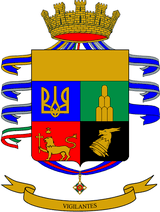4th Alpine Division Cuneense
| 4a Divisione Alpina Cuneense | |
|---|---|
|
Coat of Arms of the 4th Alpine Division Cuneense | |
| Active | 31 October 1935 – 28 January 1943 |
| Country | Italy |
| Branch | Regio Esercito |
| Type | Alpini |
| Role | Mountain Infantry |
| Size | 17,460 men |
| Part of |
Italian Alpine Corps 1942-1943 |
| Garrison/HQ | Cuneo |
| Engagements |
World War II Greco-Italian War Italian War in Soviet Union |
| Commanders | |
| Notable commanders | General Emilio Battisti |
The 4th Alpine Division Cuneense was an Italian division composed of Alpini - light Mountain Infantry - and Mountain Artillery units. The division participated in all Italian campaigns of World War II with the exception of the North African Campaign. The division was completely destroyed by Soviet Forces during Operation Little Saturn
Formation
The Cuneense division was constituted on 31 October 1935 through the reorganization of the existing 5th Superior Alpini Command. The headquarters of the division was in the city of Cuneo, and the majority of its soldiers were drafted from the surrounding valleys - hence the name "Cuneense".
Order of battle
-
 1st Alpini Regiment based in Mondovì
1st Alpini Regiment based in Mondovì
-
 Ceva battalion
Ceva battalion -
 Pieve di Teco battalion
Pieve di Teco battalion -
 Mondovì battalion
Mondovì battalion
-
-
 2nd Alpini Regiment based in Cuneo
2nd Alpini Regiment based in Cuneo
-
 Borgo San Dalmazzo battalion
Borgo San Dalmazzo battalion -
 Dronero battalion
Dronero battalion -
 Saluzzo battalion
Saluzzo battalion
-
- 4th Alpine Artillery Regiment based in Cuneo
- Pinerolo artillery group
- Mondovì artillery group
- Val Po artillery group
-
 4th Engineer Battalion based in Peveragno
4th Engineer Battalion based in Peveragno -
 2nd Logistic Battalion based in Busca
2nd Logistic Battalion based in Busca - 201st Auto-Transport Battalion based in Cuneo
- 413th, 414th Carabinieri Companies based in Cuneo
- 701st Heavy Armament Company based in Borgo San Dalmazzo
- 613th, 614th, 616th, 617th Field Hospitals based in Spinetta
The division strength was 573 officers and 16,887 NCOs and soldiers for a total strength of 17,460 men. The division also had 176 horses, 4,698 mules and 584 transport vehicles at its disposal.
Battle of France
On 21 June 1940 (one day before the French surrender) the “Cuneense” division began to advance with other Italian units into Southern France.
Greco-Italian War
The division was then sent to Albania, where it participated in the Greco-Italian War. As the German Wehrmacht came to the aid of the beaten Italian armies in Albania in April 1941 through an invasion of Yugoslavia the “Cuneense” was sent north to aid the rapidly advancing German divisions. The Cuneense advanced through Montenegro and reached Dubrovnik at the end of the campaign.
Italian participation in the Eastern Front
In September 1942 the “Cuneense” was sent with the Alpini divisions Julia and Tridentina and other Italian units to the Soviet Union to form the Mountain Corps of the Italian Army in Russia (Armata Italiana in Russia, or ARMIR) and fight alongside the Germans against the Red Army. Taking up positions along the Don river the Italian units covered part of the left flank of the German Sixth Army, which spearheaded the German summer offensive of 1942 into the city of Stalingrad.
After the Red Army successfully encircled the German Sixth Army in Stalingrad during Operation Uranus, Soviet attention turned to the Italian and Hungarian units along the Don. On 13 January 1943 the Soviet offensive Operation Little Saturn began and the three Alpini divisions found themselves quickly encircled by the rapidly advancing armoured forces of Soviet General Filipp Golikov's Voronezh Front. The Alpinis held the front on the river Don, but within three days the Soviets advanced 200 km to the left and right of the Alpini. On the evening of 17 January the commanding officer of the corps General Gabriele Nasci finally ordered a full retreat. At this point the Julia and Cuneense divisions were already heavily decimated and only the Tridentina division was still capable of conducting combat operations.
The 40,000 men strong mass of stragglers - Alpinis and Italians from other commands, plus various Germans and Hungarians - formed two columns, that followed the Tridentina division, supported by a handful of German armoured vehicles, which led the way westwards to the new Axis front. On 24 January the Cuneense formed its own column and marched south of the Tridentina division. As the Soviets had already occupied every village bitter battles had to be fought to clear the way. On the morning of 28 January the division had walked 200 km, fought 20 battles, lost 80% of its men and spent 11 nights camped out in the middle of the Russian Steppe. Temperatures during the nights were between -30 °C and -40 °C. During the 28th the last remnants of the division were annihilated by Cossack forces. The last survivors of the 1st Alpini regiment burned the regiment's flag to prevent it from falling into enemy hands. The Cuneense then ceased to exist.
On 11 February 1943 the count of the survivors gave the following result:[1]
- 1st Alpini Regiment out of 5,206 men: 722 survivors; none of the soldiers of the battalions Ceva, Pieve di Teco and Mondovì survived.
- 2nd Alpini Regiment out of 5,206 men: 208 survivors; none of the soldiers of the battalions Borgo San Dalmazzo and Saluzzo survived.
- 4th Alpine Artillery Regiment out of 3,897 men: 379 survivors; none of the soldiers of the Artillery Group Mondovì survived.
- 4th Mixed Engineer Battalion out of 1,240 men: 139 survivors
- Support units out of 1,313 men: 159 survivors
In total 1,607 men of the division's total of 17,460 survived Operation Little Saturn.
References
- ↑ http://www.alpini-cuneense.it/cadutiedispersi.htm Report to the Italian Army High Command, 11 February 1943
Sources
Homepage of the 4th Alpine Division Cuneense
